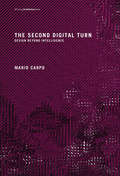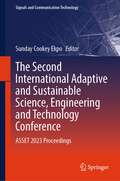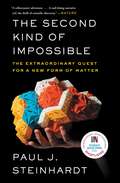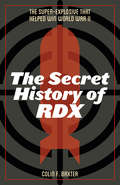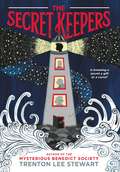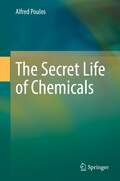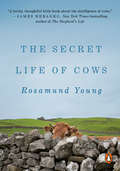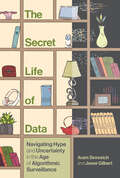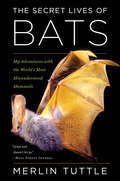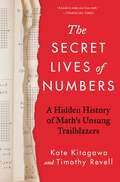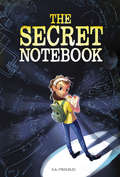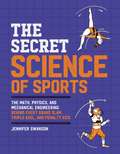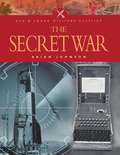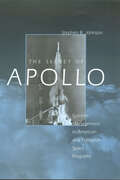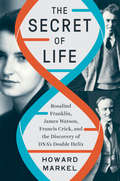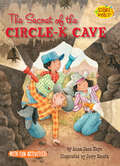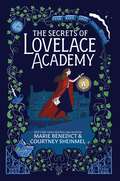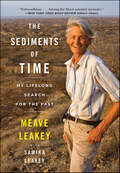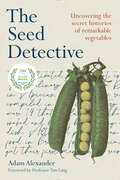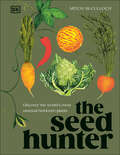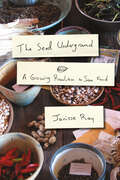- Table View
- List View
The Second Day at Gettysburg
by Gary GallagherDifferent historians examine commanders who fought at Gettysburg.
The Second Digital Turn: Design Beyond Intelligence (Writing Architecture)
by Mario CarpoThe first digital turn in architecture changed our ways of making; the second changes our ways of thinking.Almost a generation ago, the early software for computer aided design and manufacturing (CAD/CAM) spawned a style of smooth and curving lines and surfaces that gave visible form to the first digital age, and left an indelible mark on contemporary architecture. But today's digitally intelligent architecture no longer looks that way. In The Second Digital Turn, Mario Carpo explains that this is because the design professions are now coming to terms with a new kind of digital tools they have adopted—no longer tools for making but tools for thinking. In the early 1990s the design professions were the first to intuit and interpret the new technical logic of the digital age: digital mass-customization (the use of digital tools to mass-produce variations at no extra cost) has already changed the way we produce and consume almost everything, and the same technology applied to commerce at large is now heralding a new society without scale—a flat marginal cost society where bigger markets will not make anything cheaper. But today, the unprecedented power of computation also favors a new kind of science where prediction can be based on sheer information retrieval, and form finding by simulation and optimization can replace deduction from mathematical formulas. Designers have been toying with machine thinking and machine learning for some time, and the apparently unfathomable complexity of the physical shapes they are now creating already expresses a new form of artificial intelligence, outside the tradition of modern science and alien to the organic logic of our mind.
The Second International Adaptive and Sustainable Science, Engineering and Technology Conference: ASSET 2023 Proceedings (Signals and Communication Technology)
by Sunday Cookey EkpoThis proceedings presents papers from the Second International Adaptive and Sustainable Science, Engineering and Technology Conference (ASSET 2023), which took place simultaneously in Manchester, UK and Ikot Akpaden, Nigeria on 18-20, July 2023. The ASSET conference serves as an interactive forum for the advancement of the practice of adaptive and sustainable systems across the multiple disciplines and specialty areas involved with the science, engineering, and technology of integrated entities, complex systems, and networks. The conference provides an avenue for practitioners, researchers, managers, developers, analysts, educators, and users to exchange innovative ideas, concepts, applications, and lessons learned in addressing domain-specific problems, applications-oriented topics, methodologies, standards and multidisciplinary research opportunities and findings relating to ASSET systems.
The Second Kind of Impossible: The Extraordinary Quest for a New Form of Matter
by Paul SteinhardtOne of the most fascinating scientific detective stories of the last fifty years, an exciting quest for a new form of matter. The Second Kind of Impossible reads like James Gleick’s Chaos combined with an Indiana Jones adventure.When leading Princeton physicist Paul Steinhardt began working in the 1980s, scientists thought they knew all the conceivable forms of matter. The Second Kind of Impossible is the story of Steinhardt’s thirty-five-year-long quest to challenge conventional wisdom. It begins with a curious geometric pattern that inspires two theoretical physicists to propose a radically new type of matter—one that raises the possibility of new materials with never before seen properties, but that violates laws set in stone for centuries. Steinhardt dubs this new form of matter “quasicrystal.” The rest of the scientific community calls it simply impossible. The Second Kind of Impossible captures Steinhardt’s scientific odyssey as it unfolds over decades, first to prove viability, and then to pursue his wildest conjecture—that nature made quasicrystals long before humans discovered them. Along the way, his team encounters clandestine collectors, corrupt scientists, secret diaries, international smugglers, and KGB agents. Their quest culminates in a daring expedition to a distant corner of the Earth, in pursuit of tiny fragments of a meteorite forged at the birth of the solar system. Steinhardt’s discoveries chart a new direction in science. They not only change our ideas about patterns and matter, but also reveal new truths about the processes that shaped our solar system. The underlying science is important, simple, and beautiful—and Steinhardt’s firsthand account is an engaging scientific thriller.
The Secret History of RDX: The Super-Explosive that Helped Win World War II
by Colin F. BaxterThe noted historian offers &“a compelling sociohistorical account of an often overlooked yet critical&” WWII explosive twice as powerful as TNT (Choice).During the early years of World War II, American ships crossing the Atlantic were virtually defenseless against German U-boats. Bombs and torpedoes fitted with TNT barely dented the hulls of Axis naval vessels. Then, seemingly overnight, a top-secret manufacturing plant appeared near Kingsport, Tennessee, producing a sugar-white substance called Research Department Explosive, code name RDX.Twice as deadly as TNT and overshadowed only by the atomic bomb, RDX proved to be pivotal in the Battle of the Atlantic and directly contributed to the Allied victory in WWII. In The Secret History of RDX, Colin F. Baxter documents the journey of the super-explosive from conceptualization at Woolwich Arsenal in England to mass production at Holston Ordnance Works in east Tennessee. Baxter examines the debates between RDX advocates and their opponents and explores the use of the explosive in the bomber war over Germany, in the naval war in the Atlantic, and as a key element in the trigger device of the atomic bomb.Drawing on archival records and interviews with individuals who worked at the Kingsport &“powder plant,&” Baxter illuminates both the explosive&’s military significance and its impact on the lives of ordinary Americans involved in the war industry. Much more than a technical account, this study assesses the social and economic impact of the military-industrial complex on small communities on the home front.
The Secret Keepers
by Trenton Lee Stewart Diana Sudyka<br>A magical watch <br>A string of secrets <br>A race against time <P>When Reuben discovers an extraordinary antique watch, he soon learns it has a secret power and his life takes an intriguing turn. At first he is thrilled with his new treasure, but as one secret leads to another, Reuben finds himself torn between his innately honest nature and the lure to be a hero. <P>Now he is on a dangerous adventure--full of curious characters, treacherous traps, and hairsbreadth escapes--as he races to solve the mystery before it is too late. Even with fearless Penny, mighty Jack, and the wise Mrs. Genevieve on his side, can Reuben outwit and outmaneuver the sly villain called The Smoke and his devious defenders the Directions and save the city from a terrible fate? <P>In this ingeniously crafted novel, acclaimed New York Times bestselling author Trenton Lee Stewart invites readers to join the adventure, decipher the clues, and ask themselves the question: Is knowing a secret a gift or a curse? <P><b>A New York Times Bestseller</b>
The Secret Life of Chemicals
by Alfred PoulosThis book provides extensive information on the chemicals that inhabit our environment, our food, our water and our air and the impact that they may be having on human health. The author is a medical scientist, with training in the law. The book documents current understanding about pesticides in food, the plastics revolution, toxic metals, air, water and electronic waste pollutants, chemical exposure in the workplace, radiation pollutants, chemical exposure and hearing loss, how our bodies deal with chemicals, genetic variability and the risk of disease, the effect of chemicals on genes, mitochondria and the immune system and what we can do about it all. Industrialisation has resulted in many thousands of chemicals, which are being continuously developed and often escaping from where they are used into our human environment, without us really knowing enough about them. In high dosages or with continuous small dosage, the evidence suggests, that many of them could interfere with human health and some of them are known to be doing so. But for the vast majority, we are left wondering whether some could be responsible for some diseases the causes of which are inadequately understood. Every chapter is thoroughly reinforced with several pages of references from the peer-reviewed literature.
The Secret Life of Cows
by Rosamund Young"Within a day of receiving this book, I had consumed it... Absorbing, moving, and compulsively readable."—Lydia DavisIn this affectionate, heart-warming chronicle, Rosamund Young distills a lifetime of organic farming wisdom, describing the surprising personalities of her cows and other animalsAt her famous Kite's Nest Farm in Worcestershire, England, the cows (as well as sheep, hens, and pigs) all roam free. They make their own choices about rearing, grazing, and housing. Left to be themselves, the cows exhibit temperaments and interests as diverse as our own. "Fat Hat" prefers men to women; "Chippy Minton" refuses to sleep with muddy legs and always reports to the barn for grooming before bed; "Jake" has a thing for sniffing the carbon monoxide fumes of the Land Rover exhaust pipe; and "Gemima" greets all humans with an angry shake of the head and is fiercely independent.An organic farmer for decades, Young has an unaffected and homely voice. Her prose brims with genuine devotion to the wellbeing of animals. Most of us never apprehend the various inner lives animals possess, least of all those that we might eat. But Young has spent countless hours observing how these creatures love, play games, and form life-long friendships. She imparts hard-won wisdom about the both moral and real-world benefits of organic farming. (If preserving the dignity of animals isn't a good enough reason for you, consider how badly factory farming stunts the growth of animals, producing unhealthy and tasteless food.)This gorgeously-illustrated book, which includes an original introduction by the legendary British playwright Alan Bennett, is the summation of a life's work, and a delightful and moving tribute to the deep richness of animal sentience.
The Secret Life of Data: Navigating Hype and Uncertainty in the Age of Algorithmic Surveillance (The Information Society Series)
by Aram Sinnreich Jesse GilbertHow data surveillance, digital forensics, and generative AI pose new long-term threats and opportunities—and how we can use them to make better decisions in the face of technological uncertainty.In The Secret Life of Data, Aram Sinnreich and Jesse Gilbert explore the many unpredictable, and often surprising, ways in which data surveillance, AI, and the constant presence of algorithms impact our culture and society in the age of global networks. The authors build on this basic premise: no matter what form data takes, and what purpose we think it&’s being used for, data will always have a secret life. How this data will be used, by other people in other times and places, has profound implications for every aspect of our lives—from our intimate relationships to our professional lives to our political systems.With the secret uses of data in mind, Sinnreich and Gilbert interview dozens of experts to explore a broad range of scenarios and contexts—from the playful to the profound to the problematic. Unlike most books about data and society that focus on the short-term effects of our immense data usage, The Secret Life of Data focuses primarily on the long-term consequences of humanity&’s recent rush toward digitizing, storing, and analyzing every piece of data about ourselves and the world we live in. The authors advocate for &“slow fixes&” regarding our relationship to data, such as creating new laws and regulations, ethics and aesthetics, and models of production for our data-fied society.Cutting through the hype and hopelessness that so often inform discussions of data and society, The Secret Life of Data clearly and straightforwardly demonstrates how readers can play an active part in shaping how digital technology influences their lives and the world at large.
The Secret Lives of Bats: My Adventures with the World's Most Misunderstood Mammals
by Merlin TuttleStories and science surrounding the beloved bat, from an ecologist who has dedicated his life to the curious creature.Few people realize how sophisticated and intelligent bats are. Merlin Tuttle knows, and he has stopped at nothing to find and protect them on every continent they inhabit. Sharing highlights from a lifetime of adventure and discovery, Tuttle takes us to the frontiers of bat research to show that frog-eating bats can identify frogs by their calls, that some bats have social sophistication similar to that of higher primates, and that bats have remarkable memories. Bats also provide enormous benefits by eating crop pests, pollinating plants, and carrying seeds needed for reforestation. They save farmers billions of dollars annually and are essential to a healthy planet. Tuttle&’s account forever changes the way we see these poorly understood yet fascinating creatures. &“Grips and doesn't let go.&”—Wall Street Journal&“It&’s a terrific read.&”—Huffington Post &“A whirlwind adventure story and a top-shelf natural history page-turner.&”—Sy Montgomery, author of The Soul of an Octopus&“One of the best, most interesting books I&’ve ever read.&”—Elizabeth Marshall Thomas, author of The Hidden Life of Dogs
The Secret Lives of Numbers: A Hidden History of Math's Unsung Trailblazers
by Kate Kitagawa Timothy RevellShortlisted for the 2024 British Academy Book PrizeA new history of mathematics focusing on the marginalized voices who propelled the discipline, spanning six continents and thousands of years of untold stories."A book to make you love math." —Financial TimesMathematics shapes almost everything we do. But despite its reputation as the study of fundamental truths, the stories we have been told about it are wrong—warped like the sixteenth-century map that enlarged Europe at the expense of Africa, Asia and the Americas. In The Secret Lives of Numbers, renowned math historian Kate Kitagawa and journalist Timothy Revell make the case that the history of math is infinitely deeper, broader, and richer than the narrative we think we know.Our story takes us from Hypatia, the first great female mathematician, whose ideas revolutionized geometry and who was killed for them—to Karen Uhlenbeck, the first woman to win the Abel Prize, “math’s Nobel.” Along the way we travel the globe to meet the brilliant Arabic scholars of the “House of Wisdom,” a math temple whose destruction in the Siege of Baghdad in the thirteenth century was a loss arguably on par with that of the Library of Alexandria; Madhava of Sangamagrama, the fourteenth-century Indian genius who uncovered the central tenets of calculus 300 years before Isaac Newton was born; and the Black mathematicians of the Civil Rights era, who played a significant role in dismantling early data-based methods of racial discrimination.Covering thousands of years, six continents, and just about every mathematical discipline, The Secret Lives of Numbers is an immensely compelling narrative history.
The Secret Notebook
by D.A. D'AurelioRiley Green is certain her lie detector pen will improve her status in a school full of kids from the most powerful families of Washington, D.C. But her plan collapses when her invention idea is stolen, her favorite teacher goes missing, and mysterious threats begin to appear around capital. Before vanishing, Riley's teacher entrusts her with her most prized possession, the lost notebook of Nikola Tesla, legendary inventor and scientist. Now Riley and her friends must protect the notebook from thieves who want to steal the details it holds about a dangerous invention. When Riley discovers another secret, she must decode a mysterious message before it's too late. Her teacher's life depends on it.
The Secret Science of Ciphers
by Nick D'AltoEven if you aren't a spy, you probably already use cryptography, or the science of secret communication, every day.
The Secret Science of Sports: The Math, Physics, and Mechanical Engineering Behind Every Grand Slam, Triple Axel, and Penalty Kick
by Jennifer SwansonWhy does a football spiral? How do some athletes jump so high? The answer is science! The Secret Science of Sports helps kids better understand concepts of science, technology, engineering, and math through the sports they love to play and watch. Every sport -- from baseball to basketball, to football and soccer, to wrestling, tennis, and lacrosse -- involves a bit of science, technology, engineering, and math. You can't throw a ball without Newton's Law of Motion, and you can't calculate a player's stats without math. And every type of sports equipment -- a helmet, cleats, shoulder or knee pads -- were designed with the latest engineering and technology. The Secret Science of Sports breaks down normally difficult STEM concepts like forces of motion, gravity, algebra, and even neuroscience, in a language kids can -- and will want to -- understand. Divided into sections like chemistry, biology, physics, technology, and more, this handy guide uses examples from sports like soccer, baseball, softball, football, hockey, lacrosse, tennis, and others to explain important STEM concepts for kids ages 8 to 12. They'll learn how to use math to calculate a batter's average, why a tennis racket is shaped the way it is, how biology affects athletic performance, the aerodynamics behind competitive swimsuits, and much more. With dozens of original, captivating illustrations to engage young readers, kids will have fun while learning about key STEM ideas that will prepare them for years of schooling to come.
The Secret War (Pen & Sword Military Classics)
by Brian JohnsonA look at the scientists and technicians whose hard work off the battlefield assisted the Allied Forces in winning the World War II. Based on the BBC television documentary series of the same name, this book offers a behind-the-scenes look at the fight by the &“back room&” scientists and technicians of the Second World War, including the battles against the Luftwaffe navigational beams, the V-1 and V-2 flying bombs, the development of radar, the battle against the U-boats, countering the magnetic mine, and the breaking of the codes produced by the Enigma machines.
The Secret of Apollo: Systems Management in American and European Space Programs (New Series in NASA History)
by Stephen B. JohnsonWinner of the Emme Award for Astronautical Literature from the American Astronautical SocietyHow does one go about organizing something as complicated as a strategic-missile or space-exploration program? Stephen B. Johnson here explores the answer—systems management—in a groundbreaking study that involves Air Force planners, scientists, technical specialists, and, eventually, bureaucrats. Taking a comparative approach, Johnson focuses on the theory, or intellectual history, of "systems engineering" as such, its origins in the Air Force's Cold War ICBM efforts, and its migration to not only NASA but the European Space Agency.Exploring the history and politics of aerospace development and weapons procurement, Johnson examines how scientists and engineers created the systems management process to coordinate large-scale technology development, and how managers and military officers gained control of that process. "Those funding the race demanded results," Johnson explains. "In response, development organizations created what few expected and what even fewer wanted—a bureaucracy for innovation. To begin to understand this apparent contradiction in terms, we must first understand the exacting nature of space technologies and the concerns of those who create them."
The Secret of Apollo: Systems Management in American and European Space Programs (New Series in NASA History)
by Stephen B. Johnson&“Skillfully interweaving technical details and fascinating personalities, Johnson tells the history of systems management in the U.S. and Europe.&” —Howard McCurdy, author of Space and the American Imagination Winner of the Emme Award for Astronautical Literature from the American Astronautical Society How does one go about organizing something as complicated as a strategic-missile or space-exploration program? Stephen B. Johnson here explores the answer—systems management—in a groundbreaking study that involves Air Force planners, scientists, technical specialists, and, eventually, bureaucrats. Taking a comparative approach, Johnson focuses on the theory, or intellectual history, of &“systems engineering&” as such, its origins in the Air Force&’s Cold War ICBM efforts, and its migration to not only NASA but the European Space Agency. Exploring the history and politics of aerospace development and weapons procurement, Johnson examines how scientists and engineers created the systems management process to coordinate large-scale technology development, and how managers and military officers gained control of that process. &“Those funding the race demanded results,&” Johnson explains. &“In response, development organizations created what few expected and what even fewer wanted—a bureaucracy for innovation. To begin to understand this apparent contradiction in terms, we must first understand the exacting nature of space technologies and the concerns of those who create them.&”&“Johnson&’s in-depth, nuts-and-bolts manual sheds much light on a seldom studied secret of our recent space history.&” —Space Review&“A book for general readers interested in business and management issues in the space program.&” —Choice
The Secret of Life: Rosalind Franklin, James Watson, Francis Crick, And The Discovery Of Dna's Double Helix
by Howard MarkelAn authoritative history of the race to unravel DNA’s structure, by one of our most prominent medical historians. James Watson and Francis Crick’s 1953 discovery of the double helix structure of DNA is the foundation of virtually every advance in our modern understanding of genetics and molecular biology. But how did Watson and Crick do it—and why were they the ones who succeeded? In truth, the discovery of DNA’s structure is the story of five towering minds in pursuit of the advancement of science, and for almost all of them, the prospect of fame and immortality: Watson, Crick, Rosalind Franklin, Maurice Wilkins, and Linus Pauling. Each was fascinating and brilliant, with strong personalities that often clashed. Howard Markel skillfully re-creates the intense intellectual journey, and fraught personal relationships, that ultimately led to a spectacular breakthrough. But it is Rosalind Franklin—fiercely determined, relentless, and an outsider at Cambridge and the University of London in the 1950s, as the lone Jewish woman among young male scientists—who becomes a focal point for Markel. The Secret of Life is a story of genius and perseverance, but also a saga of cronyism, misogyny, anti-Semitism, and misconduct. Drawing on voluminous archival research, including interviews with James Watson and with Franklin’s sister, Jenifer Glynn, Markel provides a fascinating look at how science is done, how reputations are undone, and how history is written, and revised. A vibrant evocation of Cambridge in the 1950s, Markel also provides colorful depictions of Watson and Crick—their competitiveness, idiosyncrasies, and youthful immaturity—and compelling portraits of Wilkins, Pauling, and most cogently, Rosalind Franklin. The Secret of Life is a lively and sweeping narrative of this landmark discovery, one that finally gives the woman at the center of this drama her due.
The Secret of the Circle-K Cave (Science Solves It!)
by Anna Jane HaysSolve kid-sized dilemmas and mysteries with the Science Solves It! series. These fun books for kids ages 5–8 blend clever stories with real-life science. Why did the dog turn green? Can you control a hiccup? Is that a UFO? Find the answers to these questions and more as kid characters dive into physical, life, and earth sciences. Rick is headed out west to his aunt and uncle&’s dude ranch. He gets to ride a horse and see the local wildlife. But best of all, Rick and his cousins find a cool cave nearby. Maybe the cave holds the key to a century-old stagecoach robbery! Books in this perfect STEM series will help kids think like scientists and get ahead in the classroom. Activities and experiments are included in every book! (Level One; Science topic: Caves)
The Secret of the Stradivarius (Fountas & Pinnell Classroom, Guided Reading)
by Jackie LeteraNIMAC-sourced textbook. Legendary Instruments. Stradivarius violins are legendary—widely believed to be some of the most perfect instruments ever made—but no one knows why these three-hundred-year-old violins sound better than other violins. For many years, people have tried to unlock the secrets of what makes a Stradivarius superior to modern violins. Some, however, have considered a different question: what if there's no secret, and they aren't actually better?
The Secrets of Lovelace Academy
by Courtney Sheinmel Marie BenedictFrom New York Times bestselling author Marie Benedict and Courtney Sheinmel comes a historical adventure about a young girl plucked from a London orphanage to begin attending a boarding school with more secrets than she could imagine—perfect for fans of Enola Holmes.Lainey Philipps has lived at the Sycamore Home for Orphaned Children since she was three years old. Now nearly a teenager, her life is hard, and she doesn&’t expect it to get better—until a chance encounter during an open house changes everything when Lainey meets a woman who invites her to attend the prestigious Lovelace Academy. Fitting in amongst the many privileged students within the ivy-covered walls of Lovelace Academy presents challenges unlike the ones Lainey has faced in the past. Her life of drudgery has hardly prepared her for the aristocratic airs and cutthroat academic ambition of the other girls. Terrified she&’ll be cast out of the academy, Lainey grabs at her chance to prove herself by traveling to Switzerland to meet a female scientist crafting a groundbreaking theory. Determined to prove her capability and reach her destination, Lainey must rely on her own wit—as well as a mysterious boy who has yet to prove himself as friend or foe. But the real test is what awaits her in Switzerland, at the home of Mileva Maric, wife of Albert Einstein.
The Sediments of Time: My Lifelong Search for the Past
by Meave Leakey Samira Leakey"Extraordinary . . . This inspirational autobiography stands among the finest scientist memoirs." —New York Times Book Review, Editors' ChoiceMeave Leakey&’s thrilling, high-stakes memoir—written with her daughter Samira—encapsulates her distinguished life and career on the front lines of the hunt for our human origins, a quest made all the more notable by her stature as a woman in a highly competitive, male-dominated field. In The Sediments of Time, preeminent paleoanthropologist Meave Leakey brings us along on her remarkable journey to reveal the diversity of our early pre-human ancestors and how past climate change drove their evolution. She offers a fresh account of our past, as recent breakthroughs have allowed new analysis of her team&’s fossil findings and vastly expanded our understanding of our ancestors. Meave&’s own personal story is replete with drama, from thrilling discoveries on the shores of Lake Turkana to run-ins with armed herders and every manner of wildlife, to raising her children and supporting her renowned paleoanthropologist husband Richard Leakey&’s ambitions amidst social and political strife in Kenya. When Richard needs a kidney, Meave provides him with hers, and when he asks her to assume the reins of their field expeditions after he loses both legs in a plane crash, the result of likely sabotage, Meave steps in. The Sediments of Time is the summation of a lifetime of Meave Leakey&’s efforts; it is a compelling picture of our human origins and climate change, as well as a high-stakes story of ambition, struggle, and hope."A fascinating glimpse into our origins. Meave Leakey is a great storyteller, and she presents new information about the far off time when we emerged from our ape-like ancestors to start the long journey that has led to our becoming the dominant species on Earth. That story, woven into her own journey of research and discovery, gives us a book that is informative and captivating, one that you will not forget."—Jane Goodall, PhD, DBE, Founder of the Jane Goodall Institute
The Seed Detective: Uncovering the Secret Histories of Remarkable Vegetables
by Adam Alexander‘Informative, enlightening and entertaining but also important.’ Mark Diacono ‘One of the most inspirational books I have encountered.’ Darina Allen ‘If you’re a vegetable growing addict or just curious about their origins, there’s something for everyone in Adam’s new book.’ Rob Smith, TV presenter 'The writing is rich . . . [This book] is a clarion call to think about our food in new ways and carefully consider where it comes from.' New Scientist Meet the Indiana Jones of vegetables on his quest to save our heritage produce. Have you ever wondered how everyday staples such as peas, kale, asparagus, beans, squash and sweetcorn ended up on our plates? Well, so did Adam Alexander. Adam’s passion for heritage vegetables was ignited when he tasted an unusual, sweet and fiery pepper while on a filmmaking project in Ukraine. Smitten by its flavour, he began to seek out local growers of old and near-forgotten varieties in a mission to bring home seeds to grow and share – saving them from being lost forever. In The Seed Detective, Adam tells of his far flung (and closer to home) seed-hunting adventures and reveals the stories behind many of our everyday vegetable heroes. How the common garden pea was domesticated from three wild species over 8,500 years ago, that the first carrots originated in Afghanistan (and were actually purple or red in colour), how Egyptian priests considered it a crime to look at a fava bean and that the Romans were fanatical about asparagus. Join The Seed Detective as he takes us on a journey that began when we left the life of hunter-gatherers to become farmers. Sharing storiesof globalisation, political intrigue, colonisation and serendipity, Adam shows us the vital part vegetables have played in our food story – and how they are the key to our future.
The Seed Hunter: Discover the World's Most Unusual Heirloom Plants
by Mitch McCullochWhy grow the same dull vegetables and herbs that fill every grocery store shelf? If you're putting in the effort and growing your own, make it something sensational!There's a thrilling diversity of rare and unusual heirloom plants out there—a riot of beauty, color, and flavor that can only be experienced by growing your own. So saddle up and join the trail blazed by Mitch the Seed Hunter as he shows you how to source, grow, and enjoy the most amazing crops from around the world.The antithesis of mass-produced hybrids and genetically modified seeds, heirloom crops provide a connection to the past, seeds that have been passed down through generations, rescued from oblivion, and preserved by a dedicated community of growers.From Italian flat onions to pink broad beans, apple-sized melons beloved by Queen Anne to purple-and-white Gniff carrots from Switzerland (almost lost to extinction), and orange okra from Japan to ancient Aztec broccoli, Mitch shares his passion for growing them all and making the most of their incredible flavors.
The Seed Underground: A Growing Revolution to Save Food
by Janisse RayThere is no despair in a seed. There's only life, waiting for the right conditions-sun and water, warmth and soil-to be set free. Everyday, millions upon millions of seeds lift their two green wings.At no time in our history have Americans been more obsessed with food. Options including those for local, sustainable, and organic food-seem limitless. And yet, our food supply is profoundly at risk. Farmers and gardeners a century ago had five times the possibilities of what to plant than farmers and gardeners do today; we are losing untold numbers of plant varieties to genetically modified industrial monocultures. In her latest work of literary nonfiction, award-winning author and activist Janisse Ray argues that if we are to secure the future of food, we first must understand where it all begins: the seed.The Seed Underground is a journey to the frontier of seed-saving. It is driven by stories, both the author's own and those from people who are waging a lush and quiet revolution in thousands of gardens across America to preserve our traditional cornucopia of food by simply growing old varieties and eating them. The Seed Underground pays tribute to time-honored and threatened varieties, deconstructs the politics and genetics of seeds, and reveals the astonishing characters who grow, study, and save them.

